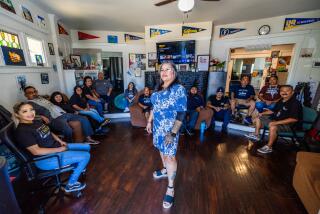Academic Look at Real-World Problem : Study of Youth Crime Promises Some Practical Results
- Share via
Westminster has been a leader in Orange County’s efforts to combat gang activity, and now the Police Department is preparing to launch another innovative program. The department has won a $150,000 federal grant for a yearlong study of the causes of delinquency in Southeast Asian youth. It’s a good subject for study in the city, which includes Little Saigon, one of the largest concentrations of Vietnamese outside Vietnam.
The department wisely enlisted help from Southeast Asian community leaders and counselors, who will sit down with academic experts in group and gang behavior to develop theories on what leads to delinquency in the ethnic community. Researchers plan to interview as many as 800 youths and family members, some of them gang members. The objective is to learn who commits crimes, why, and what could stop them.
Westminster police reported arresting 607 juveniles last year, 239 on felony charges. Police estimated that 60% of the suspected gang members in the city are Vietnamese. A social psychologist who directs the police department’s three-member research unit realistically said that the answer to fears of increasing crime by youths cannot be to “lock everyone up.” Finding out why the crimes occur and taking cultural factors into account is important.
An official of the Vietnamese Community of Orange County Inc., a nonprofit group providing a number of community services, said gang counselors are often uncertain about the family structure and economic environment of Little Saigon. He said better understanding might help police prevent crime rather than reacting to it.
Police Chief James Cook said the research unit will evaluate the effectiveness of its program and make sure any new efforts represent money well spent. That is especially important during tough economic times, when residents understandably want to be sure their tax dollars are not wasted. Cook and his officers did a good job four years ago in developing the Tri-Agency Resource Gang Enforcement Team, or TARGET. That program identifies the leaders of key gangs in the city, prosecutes them as warranted and tries to get tougher prison terms.
TARGET puts an investigator, police detectives, a deputy district attorney and a probation officer into a unit that cracks down on gangs, keeping the same people monitoring a case from arrest through prosecution. Westminster’s success in winning convictions led to the expansion of the program into other cities in Orange County.
The problems of youth crimes and gangs are hardly new. Still, law enforcement officials across the country said they worry that as children of baby boomers get older, teen crime is likely to get worse. That’s especially disquieting in light of a recent state report showing that the juvenile arrest rate for violent crime in California climbed 53% from 1985 to 1993.
TARGET has not made gangs disappear. Nor would it be realistic to expect overnight success from the study of the causes of crime among Vietnamese, Laotian and Cambodian youth. But Cook was right to use available help, from the campus and the community, to start looking for answers, especially because there are so few crime prevention programs anywhere aimed at Vietnamese youth.
More to Read
Sign up for Essential California
The most important California stories and recommendations in your inbox every morning.
You may occasionally receive promotional content from the Los Angeles Times.










